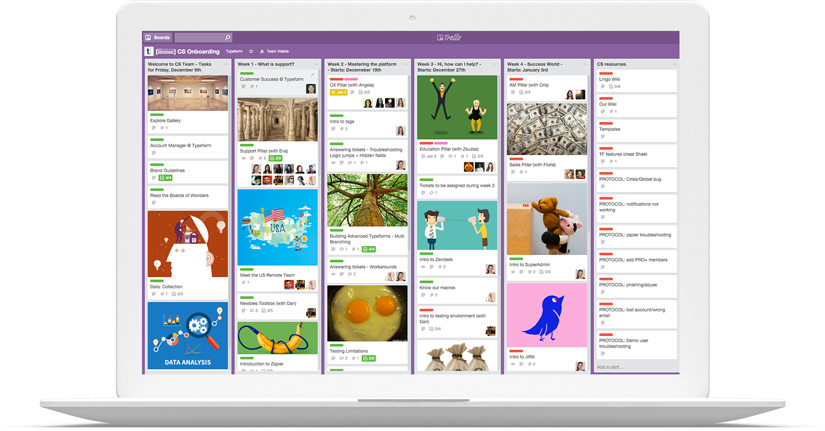How Typeform onboards its customer success staff
Every new member gets a full month of training. See why the process is so successful, and why it’s spreading across the company. <br>

Remember how it felt to join a new company? Chances are, you didn’t understand the product or know the names of anyone around you.
At this stage, people need a helpful nudge. And that big friendly nudge is called “onboarding.” When done right, onboarding turns wide-eyed newbies into extraordinary team members—meaning more confidence and a faster contribution to the team.
Want to see how our Customer Success (CS) team does it?
Begin with the end in mind
In CS, all staff members go through one month of intense onboarding. For newcomers, that means participating in training sessions, getting to know team members, and discovering unique ways they can contribute.
But a month is a long time. How do you make sure the process is worthwhile for everyone, including the people training newcomers?
Here are the 7 things that we think matter most.
1. Know the product inside out
Customer success agents need to be specialists. Because our goal is to help users create their dream typeforms and answer support questions through different channels. Expert product knowledge is a must—you can’t help if you don’t know.
2. Understand the role, team, and culture
People feel like they belong when they understand their role inside out. So we put emphasis on understanding responsibilities, team, and culture at Typeform. Because when you know and trust the people around you, you know who to ask for help, support, advice, or…. chocolate (we have a slight chocolate problem in our CS team).
3. Learn the tools
Things like Zendesk, Zapier, JIRA, Trello, or Respond (by Buffer). These are just a few of the tools that help us make our customers successful. And with tools, comes a deeper understanding of the organization’s workflows and processes.
For example, how is a ticket created in Zendesk? How can you automate a Trello task using Zapier? What makes a solid JIRA story?
Technical tools help you stay efficient. And knowing them well can make you a productivity master.
4. Map out communications
Let’s start with a few questions (quiz, yay!):
- Are tickets created when a user fills out a support request form?
- When a refund is issued, does the customer receive a confirmation message?
- Should users receive an email if a coupon has been sent out during a Christmas campaign?
Bonus points if you answered “yes” to all three.
But what does this mean for our staff?
Since users can reach out through any channel with questions, feedback, or features they’d like, then every generated message needs attention.
The lesson? Understand how messages are created and how they route to the CS team.
5. Get familiar with workflows
Does your team work in shifts? Do you offer priority support for certain users? Which tickets get preference? What if a ticket requires a specialist’s answer? Or what if a user reports a phishing case?
These are the types of workflow-related questions that can overwhelm a newbie. Make sure you clarify processes, workflows, and share all documentation to keep things cool when the heat is on.
6. Know ticket etiquette
A team member created a simple guide on how to respond to users. Our etiquette includes: say thank you, listen, be empathetic, and speak positively of the product and other teams.
Obvious right? I agree, but “don’t make assumptions” was also on that list. 😉
7. Let things sit
New recruits are swamped with new information, workflow requirements, mindset adjustments, and different tasks. A consolidation phase is needed to help solidify what they’ve learned. Plus, this helps to ensure consistently amazing service from all team members.
Alright, now that you know what to aim for with your onboarding process, where do you actually start? What are the specific steps to follow?
Let’s take a closer look at our process.
A step-by-step guide to onboarding
Remember, you’re trying to hit that tricky balance between making someone proficient without overwhelming them with information. For us, here are the steps that work best.
Track training using Trello
We use Trello to create a detailed plan of every member’s onboarding month. Newbies find it easy to navigate through their tasks and it’s simpler for us to track their progress.
Involve all team members
Everyone from our team is involved in training sessions. This includes ticket supervision, answering questions, and giving feedback. The goal? Make sure people learn about the product and know everyone on the team.
Share resources
Our Help Center is a great resource for newcomers. That’s why we involve new staff members in the Help Center’s quality assurance (QA) process as part of onboarding. Plus:
Assign one agent as a reference point
If you already have an onboarding manager, then great! But don’t forget to assign someone else as a point of contact, just in case trainees have any questions.
Pick a wide range of practice tickets
Practice tickets are past tickets submitted by users. Selected by topic, our practice tickets simulate a variety of support questions for newcomers to work out before they face live customers. It makes sure they’re ready for anything.
Review responses to real tickets
Before trainees move on to the next phase—answering real tickets in real time—it’s essential to review their first responses and give feedback before getting back to customers. This helps them develop their own support muscles and sensitivity to user difficulties.
Prepare training sessions
There’s lots to learn. Things like ticket etiquette, bug reporting, billing, social media, and technical knowledge.
Make sure training sessions are scheduled and prepared in advance—preferably by different team members. By the end of onboarding, your newbie should know every specialist on your team.
Review customer satisfaction ratings
How are trainees doing as support agents? Use metrics from your ticket platform to see customer satisfaction ratings. This lets you quickly review feedback on how they’re doing. Always remember that customers reward great support with good ratings.
Sign off when it feels right
If you’re the onboarding manager, allow yourself some space for subjective judgement. If you feel that someone isn’t ready to join the team at full speed, give them an extra few days. In exchange for that extra training time, you’ll get a more confident agent.
Continue training
Your trainee has now achieved CS agent status. It’s time for them to leave the onboarding phase and assist real customers. Don’t forget to follow up with continuous learning—it’ll only boost employee engagement.
Now on to some final tips to make sure your new colleague really excels.
Key takeaways
Information overload is real
Split your training into little digestible chunks, tasks, sessions, and practice rounds.
Get everyone involved (seriously!)
At first, I felt swamped all the time. That’s when I realized that good onboarding needs involvement from the people around you. The better everyone knows each other, the better they’ll perform.
Take an honest interest in people
Take the time to get to know people. This will let you better understand their attitudes and behaviors. It also helps you guide trainees, support them, and ultimately—improve your user’s experience.
Figure it out together
It’s important that people don’t feel alone when things feel difficult. Products can be complex, so when you say those magic words, a trainee’s focus, creativity, and efficiency skyrockets.
Hold hands at first and gradually let go
Explain as much as needed. But as time goes by, give newbies more and more space to facilitate independent decision-making.
Highlight strengths with positive feedback
Always communicate what people are doing right. Point out their strengths, then help them improve where needed.
Make it meaningful
Onboarding is an investment. Don’t rush to get a new hire acting like an expert. Be generous with your time, and provide the skills and confidence that newbies need. They’ll quickly become a resource and help your team grow at a level that will surprise you.
Asia Jarosz is responsible for leading, training, and empowering her customer success colleagues through onboarding. Originally from Wroclaw, Poland, she has also worked as a certified ICF life coach, is an accomplished cellist, and now calls Barcelona home.






